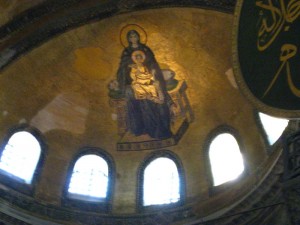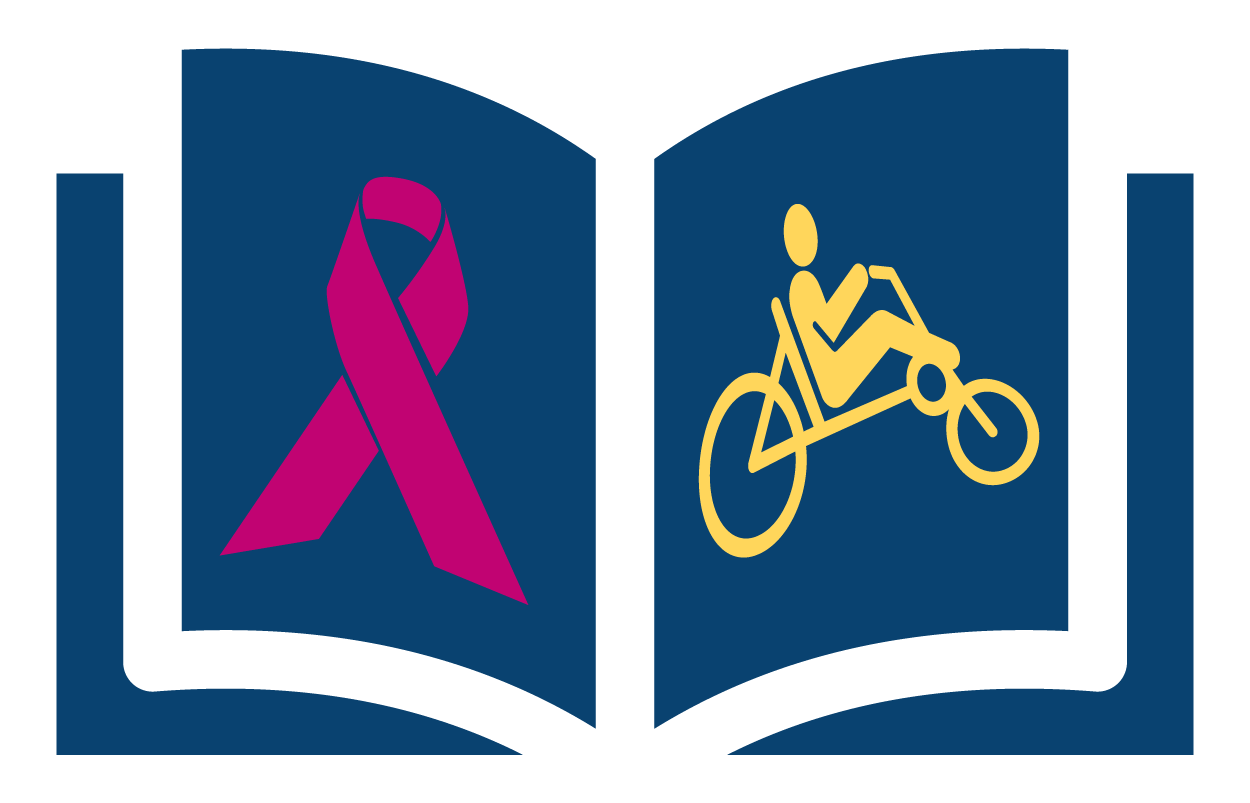Becky has had this foolish song going through her head since we planned our trip to Istanbul (lyrics from the They Might Be Giants version):
Istanbul was Constantinople
Now it’s Istanbul, not Constantinople
Been a long time gone, Constantinople
Now it’s Turkish delight on a moonlit night

We began the day with a trip to the Blue Mosque. When entering the mosque proper, the first thing we noticed was that the view of the domes is obstructed by the dark cables holding up the chandeliers. Unfortunately, that really takes away from the awe of the building. We also noticed many female tourists that did not cover their heads. Becky thinks that she would feel naked in a mosque without a head scarf. Fortunately, the buff (a tube shaped elastic scarf) that she bought in Patra works perfectly as a head scarf (as well as a neck warmer, head band, and light toque).
As we exited the mosque, there was someone collecting donations for its maintenance and upkeep. Scott put down a couple of coins, and he was handed a couple pieces of paper that looked like tickets. When we examined them, we discovered that we were give receipts for the exact amount we donated. We were rather amused with the process.

After we excited the mosque we made a stop at the tomb of Sultan Ahmet. Within were the tombs of many sultans, not just Sultan Ahmet. We were surprised to see the many small tombs (infant or toddler sized). Scott enjoyed seeing the tomb Murad IV (also known as Murad the Mad) – the sultan who reigned during the time of the 1632 books.
Our next stop was Aya Sofya (Haghia Sophia) “The Church of the Divine Wisdom”, originally built as a Christian cathedral in the sixth century and then converted to a mosque, and finally to a museum by Ataturk. From The Rough Guide to Turkey: “For almost a thousand years Aya Sofya, or Haghia Sophia, was the largest enclosed space in the world.” The 30-metre dome containing a tile mosaic was an amazing feat of engineering and architecture.
When we first saw the entrance fee: 20 YTL, we debated whether or not it was worth the price. We were surprised by it mostly because the mosque and tombs did not have any fees, and since Aya Sofya was a church we did not expect a fee – however, it is now actually a museum, so it makes sense. After a brief discussion and validation that we would regret not doing it (the regret test), we paid the fee and entered. We did not regret our decision, the Aya Sofya was Becky’s highlight of Istanbul.

At the Aya Sofya, the mosaics with gold glow when the light is just right. This is typical of Byzantine mosaics, which were designed to be viewed from flickering lantern light, and give the illusion of motion. As we were standing under the front dome mosaic with Mary holding a baby Jesus on her lap, the baby glowed. It was quite a spectacular site, that we would have been missed if the sun was not just right. We recommend seeing the church on a sunny day, and watching.
There is a large scaffolding in the main dome, which is in place as the mosaics of the dome are restored to their original glory. We like the suggestion to “Look at it from another point of view: over 120 generations of men and women have seen the interior, but very few have seen it this way.”
Scott was reminded of Guy Gavriel Kay’s “Sailing to Sarantium”, a fictionalized account of the building of the Aya Sofya by Byzantine Emperor Justinian and Empress Theodora, through the eyes of a mosaicist. Reading and loving that story made the architecture and mosaics of Aya Sofya much more meaningful and real for him. It’s unfortunate that we’re travelling to so many places that we couldn’t read the stories of each place before arriving. We have read some, and all the stories we have read have enriched our visits.
The Hippodrome, which also features prominently in the life of the Byzantine Empire would have been another high point for Scott, but unfortunately there’s nothing left but three columns and a park. The rest of the massive stone structure was used to construct other walls, houses and monuments in Istanbul. Recycling of stone in other structures is common, and much more noticeable here than in Canada – a much longer history!
After so much walking around, Becky was in need of a break. We had noticed a Starbucks, so we decided to indulge in a coffee. We have found that Starbucks provides a full size American style brewed coffee at a price much less expensive than the Turkish cafes. They also provide herbal tea at a more reasonable cost. Becky was extra delighted to learn that she could get her favourite Soy Chai Latte – and it even tastes the same as at home. In some ways it seems wrong to enjoy a taste of home while away, but when you have been travelling for many months, it is nice to enjoy an occasional comfort of home – and when that comfort is actually less expensive than the local equivalent, then it is a real bonus.
While walking between the Blue Mosque and the tram station, we noticed a new phenomenon – a cooperative call to prayer (Adhan). The muezzin (the guy that performs the Adhan) at the Blue Mosque would start the call, then the muezzin at a nearby mosque would start his call. It was almost like an echo, with each waiting for the other to finish a phrase before going on to the next one. As they progressed through the call, it almost seemed like a competition (Becky’s interpretation), with each adding vocal frills and holding notes longer. Perhaps that was just our western imagination. In any case, we continue to enjoy the musical beauty of the call, even though we don’t understand the Arabic. Similar to a Christian Mass in Latin or German, if it were in English, it likely wouldn’t be so mesmerizing.
In the evening, we decided to go for a walk and check out The Grand Bazaar. It wasn’t as grand or as teeming with people as we expected, probably because we arrived shortly before 5pm on a weekday. We spent most of our time in the indoor section, which is huge. It was very easy to get turned around while walking the twisty streets and narrow alleys. There were several shops where we looked at merchandise and no one came to talk to us – we ended up walking away rather than purchasing something. Eventually, we found a few things we liked and a person at the store to help us, so we were able to complete our Christmas shopping.

Leave a Reply